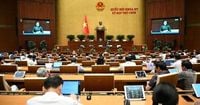Vietnam is undergoing a historic transformation in its administrative landscape as the government pushes forward with a comprehensive plan to rearrange provincial and commune-level administrative units. This ambitious initiative aims to streamline governance, boost economic development, and enhance public service efficiency across the country.
At the heart of this reform is the merging of provinces such as Ho Chi Minh City (TPHCM) with Ba Ria - Vung Tau and Binh Duong to create a mega-city with nearly 14 million residents. This new administrative structure expands the city's jurisdiction to include urban, rural, coastal, and island areas, presenting both unprecedented opportunities and challenges for governance.
According to reports from the Vietnam Fatherland Front (MTTQ) at various levels in Hung Yen province, efforts to promote awareness and consensus on the two-level administrative unit reorganization have been vigorous. The MTTQ committees have played a pivotal role in disseminating information, organizing public consultations, and securing overwhelming support—such as the 95.7% approval rate recorded in Vuong town, Tien Lu district.
Nguyen Duc Thuyet, Chairman of the MTTQ in Vuong town, emphasized the importance of clear communication to ensure that citizens understand the necessity, scope, and impact of the administrative rearrangement. This approach has fostered strong community consensus and cooperation, which is vital for the reform’s success.
Meanwhile, in Dan Tien commune, Khoai Chau district, Nguyen The Hoang, Chairman of its MTTQ committee, highlighted the psychological impact of the changes on cadres, party members, and residents. To address this, early and diverse propaganda efforts have been deployed, including village-level meetings and continuous engagement to capture public sentiment and address concerns promptly.
On the national stage, the 9th session of the 15th National Assembly, held on June 12, 2025, saw widespread support from deputies for the provincial-level administrative unit rearrangement plan. The proposal, prepared meticulously with strong theoretical and practical foundations, reflects a strategic commitment to modernizing governance, streamlining administrative apparatus, and fostering sustainable development.
Deputy Nguyen Huu Thong from Binh Thuan province reflected on the historical context, noting that while the previous three-level administrative model served the country well for decades, it now reveals limitations such as fragmented development spaces and inefficient resource allocation. The new two-level model is expected to correct these inefficiencies by enabling larger, more cohesive administrative units capable of strategic regional planning and investment attraction.
Deputy Tran Hoang Ngan from Ho Chi Minh City underscored that merging provinces is not merely an additive process of combining area and population but a multiplying effect on GDP and economic potential. The restructured provinces will have more diverse natural resources and greater capacity to develop large-scale socio-economic plans, thereby attracting stronger investment and organizing production and services more effectively.
However, challenges loom large. The expanded scale and diversity of the new administrative units require a paradigm shift in governance. Ho Chi Minh City's public service, for instance, must adapt to managing urban, rural, coastal, and island territories simultaneously. This demands enhanced managerial capacity, comprehensive policy coordination, and a keen understanding of diverse local needs.
Moreover, the transition to a two-level local government model raises concerns about maintaining seamless public service delivery. Authorities must ensure that commune-level administrations effectively assume responsibilities previously held by districts, while also proactively identifying and addressing gaps in policy and procedural frameworks.
Digital transformation emerges as a critical enabler in this context. The new administrative bodies are urged to accelerate e-governance initiatives, streamline bureaucratic procedures, and place citizens and businesses at the center of service delivery. This modernization effort is vital for fostering transparency, efficiency, and responsiveness in the expanded governance system.
In parallel, National Assembly delegate Pham Hung Thai voiced concerns regarding the potential impact of administrative rearrangements on the implementation of three national target programs. He pointed out issues such as overlapping procedures, resource allocation complexities, and the need for clear government guidance to harmonize regulations with the new administrative realities.
Delegate Thai also highlighted longstanding challenges in domestic product quality and food safety, which dampen consumer confidence. He called for thorough assessments to identify root causes and policy measures to reduce logistics and transportation costs, thereby stimulating domestic consumption.
On the environmental front, delegate Hoang Thi Thanh Thuy from Tay Ninh province revealed alarming statistics on forest degradation. In early 2025, Vietnam lost 145.4 hectares of forest, a 64% increase compared to previous periods, with deforestation rates six times higher than forest fires. These trends jeopardize the country’s commitments to carbon market development and net-zero emissions by 2050.
Delegate Thuy urged the government to strengthen forest protection policies, adjust penalty frameworks to deter illegal logging more effectively, and consider launching a national target program dedicated to forest conservation. She also called for a comprehensive review of the sustainable forestry development program to ensure adequate investment and land allocation for afforestation efforts.
The rearrangement process also entails significant human resource challenges. With nearly 448,000 personnel across 52 provinces affected, including cadres, civil servants, and public employees, the government faces the complex task of managing transfers, reassignments, and support measures. Delegates emphasized the necessity of fair, transparent policies to ensure staff welfare and maintain morale during the transition.
Salary reform is another critical aspect. As workloads increase and management scopes broaden post-merger, timely adjustments to compensation structures are essential to motivate and retain qualified personnel, especially at the commune level, where impacts are most direct.
Minister of Home Affairs Pham Thi Thanh Tra acknowledged these challenges and expressed gratitude to previous generations of leaders and civil servants who built the three-level local government system. She affirmed that the transition to a leaner, two-level model is a historic milestone, supported by strong public consensus, and will lay the foundation for a more efficient and modern governance framework.
Deputy Chairman of the National Assembly Nguyen Khac Dinh concluded the session by emphasizing the gravity and significance of the administrative rearrangement. He assured citizens and businesses that existing documents remain valid until expiration, and reissuance under new administrative names will be facilitated with simple, free procedures.
Looking ahead, the National Assembly is set to pass key resolutions and legal amendments by mid-June 2025, enabling the new administrative units to operate fully from July 1, 2025. This synchronized implementation marks a critical step in Vietnam’s ongoing journey toward modernized governance, economic vitality, and sustainable development.
In summary, Vietnam’s administrative restructuring is a bold, multifaceted endeavor designed to enhance governance efficiency, foster economic growth, and address environmental and social challenges. While the path forward involves complex transitions and adjustments, the collective commitment of government bodies, public servants, and citizens alike signals a transformative chapter in the nation’s development story.


